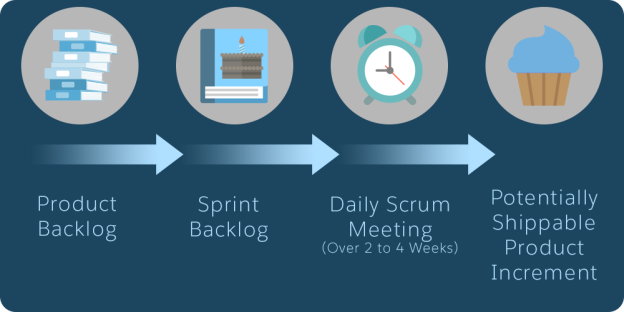Aprender los elementos del flujo de trabajo de Scrum
Después de completar esta unidad, podrá:
- Enumerar los elementos de entrega de Scrum.
- Explicar por qué es necesario finalizar el trabajo en cada esprint.
- Describir las partes clave de la lista de trabajos pendientes del producto de un equipo
Ahora que comprende la importancia de los valores y funciones de Scrum, repasemos cómo mantenemos todo organizado y en movimiento para asegurarnos de entregar de manera constante y a tiempo.
Trabajo pendiente del producto
Se trata de nuestra lista ordenada de tareas que podrían necesitarse. Lo definimos como la única fuente de verdad que describe, según nuestro mejor conocimiento, todos los cambios, actualizaciones y requisitos que creemos que se deben realizar.
¿Qué es exactamente una lista de trabajos pendientes del producto y de qué consta?
- Se refina constantemente a medida que los equipos aprenden nueva información sobre el producto.
- Los elementos de mayor prioridad tienen más detalles para que estén listos para que se trabajen.
- Incluye no solo trabajo relacionado con el proyecto, sino también tareas de soporte o mantenimiento, requisitos no funcionales e investigación.
- El propietario del producto es el responsable de la lista, y es su trabajo priorizar los elementos de trabajo.
Trabajo pendiente del esprint
El hecho de que un elemento de trabajo esté en la cola de la lista de trabajos pendientes del producto no significa que se vaya a hacer. Justo antes de cada esprint, los equipos revisan el trabajo pendiente del producto y evalúan qué elementos de trabajo de alta prioridad pueden abordar en 2 semanas. Esos proyectos se colocan en el trabajo pendiente del esprint.
Trabajo potencialmente listo para entregar
Lo más importante es que los equipos entreguen algo de valor al cliente en cada esprint. Para lograr esto, nos centramos en el resultado, y no en la producción; esa es una distinción importante en el proceso Scrum.
Dicho de una manera simple: nuestro objetivo es producir trabajo de calidad, y no cantidad de trabajo.
También nos esforzamos por completar el trabajo antes de comenzar algo nuevo. ¡A nadie le gusta llevarse a la boca un trozo de tarta medio crudo! Trabajamos de esta manera por una buena razón: cada 4 meses, Salesforce lanza actualizaciones de su plataforma. Esto no quiere decir que completemos entregas cada 4 meses. Eso no nos permitiría aprender de manera constante e incorporar esos aprendizajes cada 2 semanas, como lo hacemos ahora.
Hemos seguido entregando de esta manera durante todo el ciclo de lanzamiento para ofrecer la mejor solución.
¿Por qué enfatizamos el hecho de terminar?
En el mundo de Scrum, los proyectos que están en curso son una forma de desperdicio. Eso es porque los proyectos en curso significan que no está aprendiendo ni adaptándose para crear entregas y soluciones mejores. El trabajo que no se completa (registrado, probado y desplegado) retrasa todo el flujo de trabajo. Fomentamos una cultura en la que los equipos trabajan para ayudarse mutuamente a llevar los proyectos hasta la meta. Lo llamamos enjambre o acumulación en grupo; personas ayudándose mutuamente a terminar el último 20 % del trabajo.
